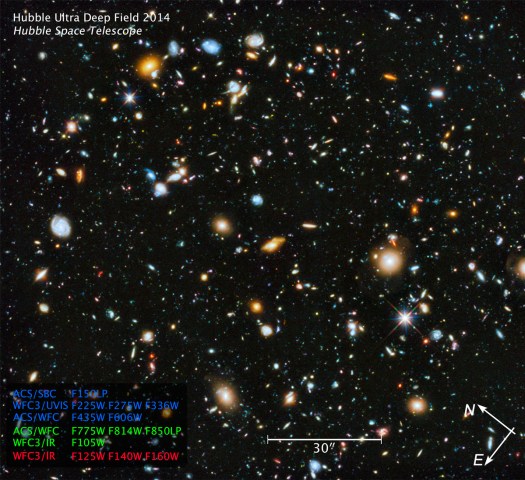You Can Paint With All The Colors of The Universe In This Stunning Hubble Image
It might be time for a Pocohontas in Space movie.

Space is full of infinite blackness, but only if you’re looking at it with your dumb limited human eyeballs. If you pan back and throw some ultraviolet light on everything, you can see a whole panorama of gorgeous colors. Good thing we have the Hubble Ultra Deep Field for just such a situation!
The HUDF is most well known as a series of images captured from 2003 to 2009, which show a small section of space in the southern-hemisphere constellation of Fornax. Astronomers have been studying the visible and near-infrared light in these images for years, but now they’ve been able to add ultaviolet light, thus completing the full range of colors available to Hubble.
This new 2014 image (click above to embiggen) is a composite of separate exposures over 824 orbits of telescope viewing time, from 2003 to 2012. It contains something like 10,000 galaxies in it, even ones that go as far back as just a few hundred million years after the Big Bang. It also looks like something out of a Lisa Frank science fiction AU. Just look at all the sparkly galaxies!
“The lack of information from ultraviolet light made studying galaxies in the HUDF like trying to understand the history of families without knowing about the grade-school children,” principal investigator Harry Teplitz said in a statement. “The addition of the ultraviolet fills in this missing range.”
Earth’s atmosphere filters out most of this ultraviolet light, so such an image could only have been captured by a space-based telescope like the Hubble. However, looking at light at these wavelengths is important, as it allows astronomers to understand how galaxies form from small collections of very hot stars. That’s because ultraviolet light only comes from the hottest, largest, and youngest stars. So kinda like, Lorde, I guess?
- Geez, Sun, you don’t look so good right now
- Astronomers are baffled by this impossible planet
- Does this nebula look like a Minecraft creeper to you?
Have a tip we should know? [email protected]